By George Beccaloni
Wallace built "The Dell" in Grays, Essex (now 25 College Avenue), paying for it using the small fortune he had earnt from the sale of the natural history specimens he collected in the Malay Archipelago. He lived in the house from March 1872 until July 1876 and during this four year period he wrote the books On Miracles and Modern Spiritualism (published March 1875) and the two volume The Geographical Distribution of Animals (published May 1876).
The Dell is notable for being one of the earliest surviving shuttered concrete houses in Britain (i.e. rather than pre-fabricated concrete). Wallace's architect Thomas Wonnacott was an early exponent of the use of this material, and had delivered a brief paper on Cement Concrete to the Royal Institute of British Architects on his election as an Associate of this organisation in 1870 (John Webb, pers. comm. 2001). The Dell is also significant in being the only one of the three houses which Wallace built for himself and his family to have survived until the present time. (The two which have been destroyed are Nutwood Cottage in Godalming, Surrey, and Old Orchard in Broadstone, Dorset).
On Saturday 14 September 2002 a cast aluminium plaque was unveiled by Wallace's grandson Richard, on wall of "The Dell" near the main entrance. The Wallace Fund designed and paid for the plaque, which forms part of a commemorative plaques scheme being run by Thurrock Local History Society, the Heritage Forum and Thurrock Council.
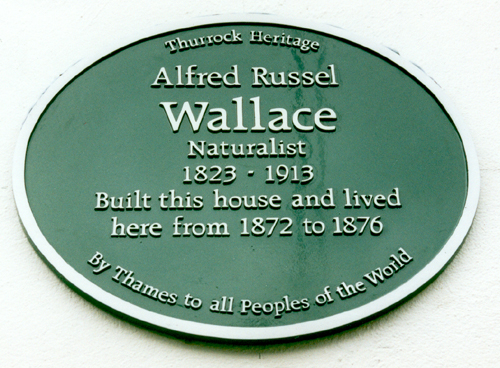 |
|
Plaque on The Dell. Copyright Janet Beccaloni |
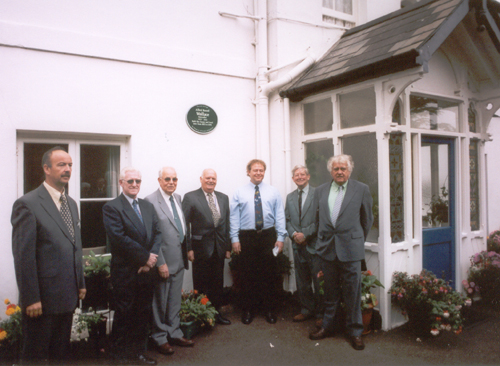 |
|
Some of the people who attended the unveiling ceremony. From left to right: Mr Jonathan Catton (Thurrock Museum), Cllr Peter Cooper (Thurrock Council), Mr John Webb (Chair of Thurrock Local History Society), Cllr George Watt (Chair of Museums in Essex Committee), Dr George Beccaloni, Mr Richard Wallace, Mr Roy Offord (Chair of Thurrock Heritage Forum). Copyright Janet Beccaloni |
Currently "The Dell" is a convent (LSU Convent) owned by the La Sainte Union Order of nuns and it is not open to the public. The plaque can, however, be seen from the road (take binoculars!).
History of "The Dell"
In 1870 Wallace was searching for a house in the countryside and found "...near the village of Grays, on the Thames, twenty miles from London, a picturesque old chalk-pit which had been disused so long that a number of large elms and a few other trees had grown up in its less precipitous portions. The chalk here was capped by about twenty feet of Thanet sand and pleistocene gravel, and from the fields at the top there was a beautiful view over Erith to the Kent hills and down a reach of the Thames to Gravesend, forming a most attractive site for a house. After some difficulty I obtained a lease for ninety-nine years of four acres, comprising the pit itself, an acre of the field on the plateau above, and about an equal amount of undulating cultivable ground between the pit and the lane which gave access to it. I had to pay seven pounds an acre rent [the equivalent of about £323 in 2001], as the owner could not sell it, and though I thought it very dear, as so much of it was unproductive, the site was so picturesque, and had such capabilities of improvement, that I thought it would be a fair investment....
As there was a deep bed of rough gravel on my ground and there were large cement works at Grays, I thought it would be economical to build of concrete, and I found an architect of experience, Mr. Wonnacott, of Farnham, who made the plans and specifications [see image 1 , image 2, image 3, image 4 , image 5], while I myself saw that the gravel was properly washed. In order to obtain water in ample quantity for building and also for the garden and other purposes, I had a well sunk about a hundred feet into a water-bearing stratum of the chalk, and purchased a small iron windmill with a two-inch force pump to obtain the water. I made two small concrete ponds in the garden--one close to the windmill--and had a large tank at the top of a low tower to supply house water. My friend Geach, the mining engineer whom I had met in Timor and Singapore, was now at home, and took an immense interest in my work. He helped me to find the windmill--the only one that we could discover in any of the engineering shops in London--and the well being completed, he and I, with the assistance of my gardener, did all the work of fitting the pump at the bottom of the well with connecting-rods and guides up to the windmill, which also we erected and set to work ourselves. As the windmill had no regulating apparatus, and, when the wind became strong, revolved far too rapidly, and even bent the connecting-rod, I attached to the ends of the iron vanes pieces of plate iron about a foot square, fixed at right angles to the line of motion. These acted as brakes as soon as the revolution became moderately rapid, but had little effect when it was slow; and the arrangement worked very well.
With the help of another labourer I also myself laid down 1¼-inch galvanized water-pipes to the house, with branches and taps where required in the garden. I also built concrete walls round the acre of ground at top, the part facing south about nine feet high for fruit trees, the rest about five feet ; and also laid out the garden, planted mounds for shelter, made a winding road from below, which, when the shrubs had grown up, became exceedingly picturesque ; and helped to shift out hundreds of cubic yards of gravel to improve the land for the kitchen garden. All this work was immensely interesting, and I have seldom enjoyed myself more thoroughly, especially as my friend Geach was a continual visitor, was always ready with his help and advice, and took as much interest in the work as I did myself. We got into the house in March, 1872, and I began to take that pleasure in gardening, and especially in growing uncommon and interesting as well as beautiful plants, which in various places, under many difficulties and with mingled failures and successes, has been a delight and solace to me ever since." (Taken from My Life (ML)).
Unfortunately Wallace had problems with the builder who had been contracted to built the house. In ML he recalls that "One day, when the house was little more than half finished, he [the builder] did not appear to pay his men, and as they would not continue to work without their money I paid them. He did not appear the next week, and sent no excuse, so the architect gave him notice that I should complete the building myself, and that, according to the agreement, he would be responsible for any cost beyond the contract price. After a few weeks he appeared, and wanted to go on, but that we declined. The house cost me somewhat more than the contract price, and when it was finished I sent him word he could have his ladders, scaffold-poles, boards, etc., though, according to the agreement, they were to be my property on his failure to finish the building.
I soon found, however, that he had not paid for a large portion of the materials, and bills kept coming in for months afterwards for bricks, timber, stone, iron-work, etc., etc. The merchants who had trusted him found that he had no effects whatever, as he lived as a lodger with his father ; and from all I heard, was accustomed to take contracts in different places round London, and by not paying for any materials that he could get on credit, make a handsome profit. But the height of his impudence was to come. About five years after the house was finished, I received a demand through a lawyer for (I think) between £800 and £900 damages for not allowing this man to finish the house! I wrote, refusing to pay a penny. Then came a notice of an action at law! and I was obliged to put it in a lawyer's hands. All the usual preliminaries of interrogatories, affidavits, statements of claim, replies, objections, etc., etc., were gone through, and on every point argued we were successful, with costs, which we never got. The case was lengthened out for two or three years, and then ceased, the result being that I had to pay about £100 law costs [the equivalent of about £6400 in 2001] for what was merely an attempt to extort money."
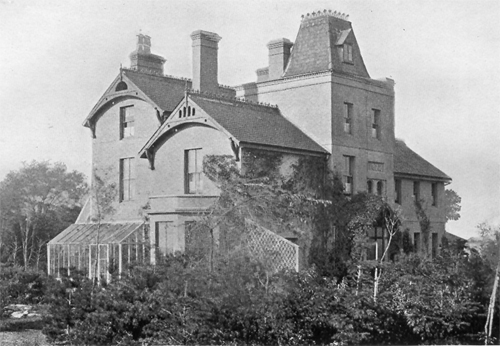 |
|
The Dell in Wallace's time. From his book "My Life" |
Raby (2001) gives the following description of The Dell: "...the house was built on a grand scale, and even had a four-roomed entrance lodge for the gardener. There was a hall, drawing room, dining room, library and conservatory on the ground floor, four principal bedrooms, dressing room and bathroom on the first floor, and four more bedrooms, or nurseries above--plenty of room for children, and servants. The rooms were spacious, high ceilinged, full of light; the style plain, but with well-chosen decorations, such as the tiles and coloured glass in the hall. Outside, the grounds were beautifully laid out, both in terms of economy--walled gardens, greenhouses, a fowl house--and pleasure: walks and terraces, ponds, a fountain, a croquet lawn, and, eventually, a rich variety of flowers and shrubs and trees." [Also see the 1876 Sale Particulars].
In a letter to Charles Darwin dated 24 November 1870 (Marchant, 1916), Wallace informed Darwin that he intended to settle in The Dell for the rest of his life, but in the event he only lived in the house for about four years. He sold the property by auction in June 1876 for a variety of reasons, including, perhaps, the fact that his young son Bertie had died (in Treeps) whilst the Wallace family were living here, and also because of financial difficulties (Chase, 1979).
Later history
The property has had several owners since 1876 when Wallace sold it, including William Winch Hughes, the founder of the Victoria Wine Company (which survived until recently). A chronological list of the owners has been compiled by John Webb of the Thurrock Local History Society, who has kindly allowed me to reproduce it on this website.
Since Wallace's time, the original estate of four acres has been sub-divided and the entrance is now off College Avenue, rather than Dell Road. Originally there was a long serpentine drive to the Dell from this road, the first part of which appears to be where Hicks Court road is now. Although the main fabric of the house has remained largely unchanged, the building was re-roofed in the mid 1990's and the water tower and the chimneys were removed. The original conservatory on the west side of the main building was replaced in 1998 (Sister Rita, pers. comm. 1999). The entrance lodge on Dell Road has been demolished (John Webb, pers. comm. 2002).
In 1999 Thurrock Council made a tree preservation order on a number of trees in the grounds of The Dell (some of which might have been planted by Wallace), and in April, 2000 Thurrock Local History Society, Thurrock Council, Thurrock Museum and Thurrock Heritage Forum (on the suggestion of the A. R. Wallace Memorial Fund) succeeded in getting The Dell designated a Grade II listed building (see the Listing document - page 1 , page 2 , page 3 ). Ironically, it was listed because of its architectural merit; not because of its link with Wallace. This contrasts with Darwin's home, Down House, which because of its association with Darwin, was granted a Grade I listing! Should The Dell be sold in the future, it is to be hoped that an organisation might purchase it and turn it into a museum which commemorates Wallace's life and work.
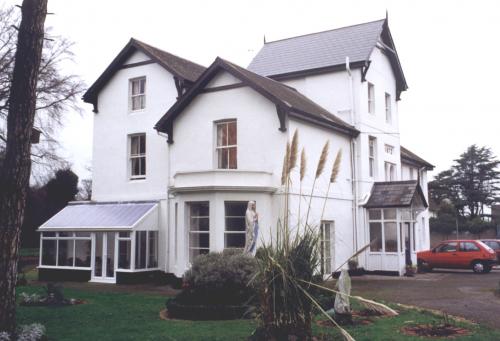 |
|
A recent picture of The Dell. Copyright G. W. Beccaloni |
References
Chase, M. 1979. A Victorian scientist at Grays: 1872-1876. Panorama: The Journal of the Thurrock Local History Society, 22: 8-17.
Marchant, J. 1916. Alfred Russel Wallace: Letters and Reminiscences. London: Cassell. 2 vols.
Raby, P. 2001. Alfred Russel Wallace, A Life. London: Chatto & Windus. 340 pp.
Wallace, A. R. 1908. My Life; A Record of Events and Opinions. London: Chapman & Hall, Ltd. pp. (i)-xii, (1)-408
Acknowledgements
The production and installation of the plaque was organised by John Webb of the Thurrock Local History Society and Jonathan Catton of Thurrock Museum. The Wallace Fund would like to thank the Sisters of the Convent for agreeing for the plaque to be erected on their house, and Thurrock Local History Society, Thurrock Museum, and Thurrock Council for their help with this project.
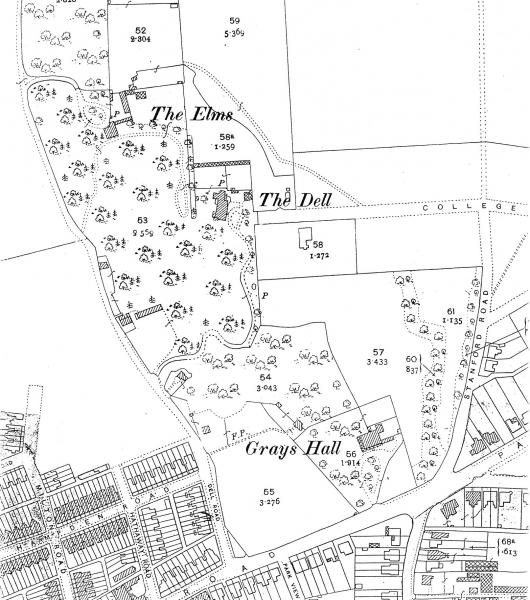
Part of Ordinance Survey map surveyed in 1862-64 and revised in 1895, showing The Dell.
